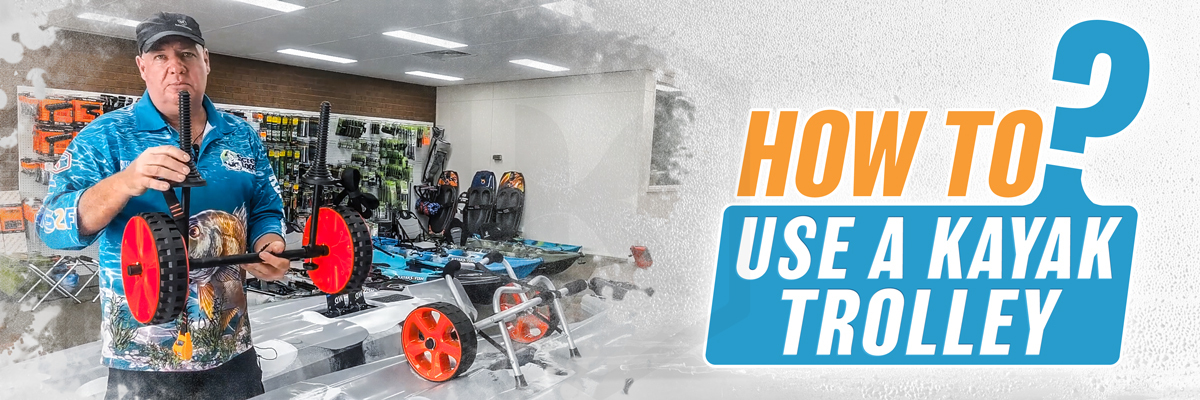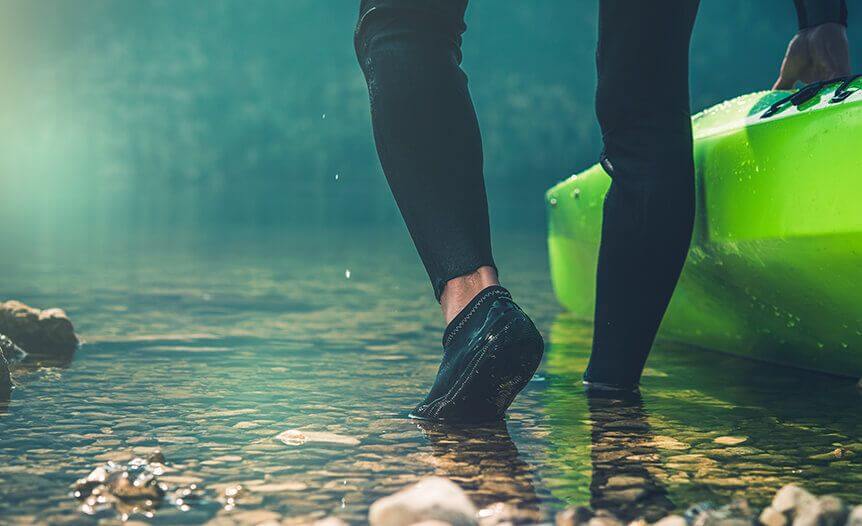How to use a kayak trolley?

Kayaking is one of those special events that can truly be enjoyed alone. You can get on the water and escape the humdrum of work and enjoy the peaceful bliss of your local waterways, paddle out into the middle of a lake, or go far from busy beaches and get away from everyone. But there can be one sticking point, and that is transporting your kayak from your vehicle to the water's edge.
When you're launching your kayak, you'll occasionally have access to a boat ramp, jetty, or purpose-built kayak launching point. But there are some secluded areas where you need to walk a few hundred metres, and these can be exhausting when you're carrying a 20kg kayak. A kayak trolley will solve this problem, and you can transport your kayak easily through all types of terrain. But how do you know which kayak trolley is best, and what do you do with it when you're ready to launch?
This article will cover all the basics (and maybe some advanced tips) about what you need to know about kayaking carts and trolleys.
Are kayak trolleys necessary?
In most situations, a kayak trolley is an absolute necessity. They'll help you transport your kayak safely to the water, and they'll offer you a way to transport your kayak to more secluded launching locations. Here are a few important issues to consider when deciding if a kayak trolley is ideal for you.
Protecting your kayak
Kayaks up to 20kg in weight can be handled by most people, but some people may struggle with the overall length to manage by themselves; this can mean they end up dragging the kayak to the water when the second person to help carry. All kayaks are designed for moving through the water, and while they may slide easily on grass and sand, doing so can cause additional (although easily avoidable) wear and tear, gravel and concrete surfaces are most likely to damage kayaks when being dragged so trolleys are a necessity if launching from areas with rough surface. A kayak trolley places the weight of any kayak to a central point, and the wheels allow for transport with minimal effort. This also enables the user the option to "cart" around other equipment you plan to bring along, from cooler boxes for drinks and snacks to fishing equipment or even some camping equipment.
Reducing any injuries
Kayaking is an excellent method of getting some impact-free exercise, but getting into the water can be something of a challenge. Sure, most people can lift kayaks, but carrying it more than about 20m and you'll soon be feeling it! Why expend all your energy doing the mundane act of getting your kayak into the water. A kayak trolley can do all the heavy lifting and save your arms and legs for paddling or anything else you plan on doing while on the water. Carrying kayaks by yourself can be managed by some depending on kayak size and length but most of the time you'd prefer to save energy and effort fun on the water.
Using a kayak trolley offers many advantages over carrying your kayak (even between two people). Firstly, you can drag (or push) your kayak on the trolley and watch where you're going. If you've ever been carrying a kayak and tripped over a branch, then you know how vital it is to see where you're going! If you're kayaking with a friend, you won't be out of breath and be able to hold a conversation, which is ideal if you're not new to the launching area and are unfamiliar with the terrain.
Save your energy for paddling
Kayaks are considered lightweight boats, but they are still reasonably heavy and beyond what most people carry on any given day. Lifting and carting a kayak for a few hundred metres can be strenuous and exhausting. You may find that when you get to the water, you need to take a quick break before launching. After a decent trip in the sun, you may have depleted most of your energy and still have an excruciating trip back to the car and loading kayak back on before leaving. Trolleys minimal effort in comparison to no trolley is a no brainer for these situations. Using a kayak trolley will save all that energy for paddling and with extra to spare for the end of the day. It's much easier to lift your kayak onto the trolley for a casual stroll back to your vehicle.
The different elements of a kayak trolley
Getting the most out of your kayak trolley means choosing one that works best for the locations you visit and your particular kayak. All kayak trolleys are designed to work with specific kayaks, and some are better going over certain types of terrain. When deciding which kayak trolley is best, you'll need to consider three things:
- What type of kayak do you have?
- What terrain do you encounter the most?
- How are you storing the trolley after you've launched?
Kayak cart support styles
There are three available kayak supports with trolleys: cones, cradle, and platform. The type you need is often dictated by the style of kayak you own.
Cone Support
Cone support trolleys use available scupper holes and are best for sit on top kayaks. The poles of the kayak trolley will slide into the available scupper holes, and cushioning is provided with two cones shaped stoppers.
Fitting this trolley style is reasonably straightforward. Remove all items from the kayak and turn it on its side to get started. Line up the arms of the trolley with the scupper holes and insert them. Finally, you can flip the kayak upright, and it'll settle onto the rubber stoppers. You can reverse this process to remove them. You can store the trolley on the kayak while you paddle by placing it upside down into the scupper holes.
We recommend you use additional straps while carting with the any trolley, this will help with the longevity of the product and kayak. Reduces unnecessary shaking and rattling while you're carting the kayak around.
Cradle Support
The cradle support works well with sit on top kayaks. It works similarly to the cone support, except it uses two pads that support your kayak using the hull. The cradle support trolley is excellent for fishing kayaks as installing it means you don't need to unload all your gear. You can lift your kayak from one end and place it on top of the trolley. Then use the straps provided with the trolley to secure it in place. Some cradle trolleys can be disassembled and stored in your kayaks hull, which frees up room on your deck for other gear.
Platform
The platform support trolley is similar to the cradle support, but it is suited to a broader range of vessels (canoes, double kayaks, stand up paddles boards, surfboards, etc.). These trolleys will use a strap to make sure everything stays safe during transport, and most models will fold to a compact size so you can take them with you.
Choosing the right wheels
When choosing your trolley, there are usually three different types of wheels available.
- Basic or Non-pneumatic tyres - suited for road, gravel paths, and sand.
- Balloon wheels - suited for soft or wet sand and grass.
- Puncture free track style - purpose designed wheels for use on sand, but work well on all surfaces.
When choosing your trolley, look through the various options and decide which is more suited to the places you like to kayak. For example, if you primarily use sea kayaks and launch from sandy areas, then beach trolleys are the best choice.
Where to put your trolley when paddling
When using a kayak trolley, you don't want to be worried about where you'll leave the trolley after you've launched. If your car is only a short walk away, you can take the trolley back to your vehicle. Trolleys that use the scupper holes can be inserted from the deck side and stored in that manner. All other trolleys will fold or disassemble for easy storage on your kayak.
Taking your trolley with you is ideal if you're kayaking to a camping spot or planning on staying overnight on an island. If you're fishing, then you may prefer a trolley that disassembles and is stored inside the hull, as that gives you more room for your fishing gear.
FAQ about kayak carts
Using a kayak trolley
How do you use a folding kayak cart?
Folding carts are often made from heavy-duty aluminium, and they work in the same way as most other carts. You can lift the rear of your kayak and place the trolley in position, and then lower your kayak. Secure the straps, and then you're ready to go.
How do you strap a kayak trolley?
The strap needs to be threaded through the trolley and left open when placing the kayak into position. After your kayak is ready, you can do up the strap and tighten it. Make sure the strap is tight and secure before heading off.
How do you store a C-Tug trolley on a kayak?
The C-Tug trolley from Railblaza can be disassembled and stored neatly in your kayaks hull. With no metal parts, you don't need to be worried about the C-Tug trolley getting wet, making it the ultimate heavy-duty trolley.
How do you make a homemade kayak trolley?
If you're into DIY, you can make your kayak trolley. Many kayakers enjoy the challenge of crafting their kayak trolley. This is a good option if you're interested in adding custom elements and accessories.
Benefits of a kayak trolley
Is a kayak cart worth it?
Using kayak carts will make kayaking more enjoyable as it removes one of the annoying aspects of the sport; carrying your kayak to the water. In the best-case scenario, you'd use a boat ramp to launch your kayak, but this limits you to particular (and often busy) locations. Kayak carts offer you the freedom to choose almost any kayaking launch location.
How much does a brand-new kayak trolley cost?
Kayak carts are priced based on the materials used, construction methods, and durability. The best carts will have spare parts available, whereas cheaper models may need complete replacing when something breaks.
Is there a suitable kayak storage compartment whilst using a kayak trolley?
Most kayak carts do not have additional storage compartments. If you need to carry things while using a cart, you can stack them on the kayak. The Heavy Load Beach trolley can be converted to a storage trolley by adding a compartment to the platform.
Can I get to the water faster using a kayak trolley?
Yes, a kayak trolleys primary purpose is to make it easier (and faster) to get your kayak to the water. These units are easy to use, and they'll store on your kayak, saving you from taking an extra trip back to your vehicle.
Where to buy a kayak trolley
At Kayaks2Fish, we have an excellent assortment of kayak trolleys and carts. The Sea to Summit kayak carts are suited with scupper holes and are an excellent all-around trolley. For all other kayak types, you can use the Foldable Kayak Trolley or the C-Tug Kayak Cart from Railblaza.
If you need any assistance in choosing the best kayaks carts, you can call our local team, and we'll offer our experience and advice.










